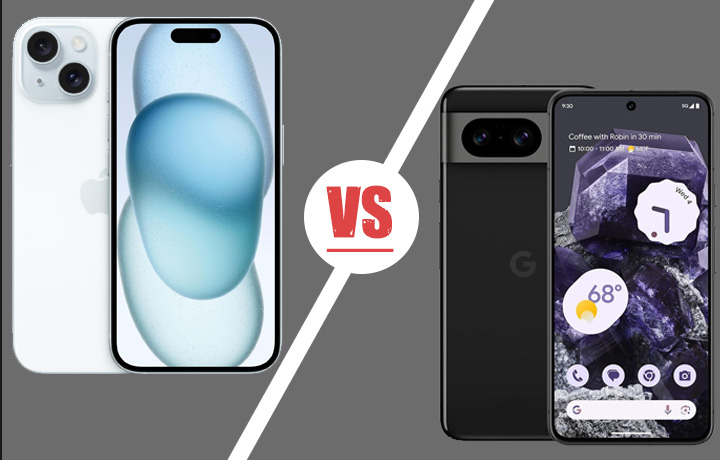Google Pixel 8 vs. iPhone 15: Is the $100 Price Difference Justified?
Google’s Pixel 8 and Apple’s iPhone 15 stand as two giants in today’s smartphone market. These flagship devices come with their own set of features, specifications, and pricing, leaving potential buyers with a crucial decision to make. Is the iPhone 15, costing $100 more than the Pixel 8, worth the premium? This comparison delves into every aspect of these two devices to help you make an informed decision. Check out their latest prices here: Apple iPhone 15 and Google Pixel 8
- Other Comparisons:
- Galaxy S23 Ultra Vs. iPhone 15 Pro Max
- iPhone 15 Vs iPhone 14
Design and Comfort
The first impression of a smartphone often comes from its design and how comfortable it feels in your hand. The iPhone 15 features a design that emphasizes comfort and ergonomics. Its slightly smaller form factor with a 6.1-inch display, combined with the frosted back and rounded edges, makes it more grippy and pleasing to hold. On the other hand, the Pixel 8, with its 6.2-inch display and sharper edges, may not be as comfortable for extended use.
A significant design difference lies in the choice of materials. The iPhone 15’s frosted back reduces fingerprint smudges and dust collection, whereas the Pixel 8’s glossy glass back is more prone to smudging and may collect dust, particularly around the camera visor. While these design variations are relatively minor, they can influence the overall user experience.
Display Technology
Both the Pixel 8 and iPhone 15 feature OLED displays, which deliver vibrant colors and deep blacks. However, a notable difference lies in the display’s refresh rate. The Pixel 8 offers a 120Hz refresh rate, allowing for smoother scrolling and improved responsiveness, which appeals to enthusiasts who appreciate a high refresh rate.
In contrast, the iPhone 15 sticks to a standard 60Hz refresh rate, which might not be a deal-breaker for everyone but could disappoint those who have experienced the benefits of higher refresh rates.
In terms of brightness, both phones offer excellent visibility even in bright sunlight. However, the Pixel 8 seems to outshine the iPhone 15 when it comes to peak brightness, which could make a difference in certain scenarios. Additionally, the Pixel 8 boasts a lower resolution than the iPhone 15, but the small screen sizes make the difference almost indistinguishable in everyday use.
Haptic Feedback
Haptic feedback, or the “feel” of the phone when interacting with it, plays a crucial role in user satisfaction. Both the Pixel 8 and iPhone 15 offer remarkable haptic feedback, providing a satisfying tactile experience. While there may not be a significant advantage to one over the other, it’s worth noting that both phones excel in this department, enhancing the overall user experience.
Camera Capabilities
The camera capabilities of a smartphone are often a deciding factor for many buyers. The Pixel 8 and iPhone 15 each bring their unique strengths and features to the table.
Face Recognition: The Pixel 8 offers a Level 3 face recognition feature, making it suitable for secure applications like mobile banking. However, it struggles in low-light conditions, requiring users to revert to the fingerprint sensor. In contrast, the iPhone 15’s Face ID remains reliable regardless of lighting conditions, which is a notable advantage.
Camera Quality: Both devices come with impressive cameras. The Pixel 8’s camera excels in dynamic range, capturing more details in challenging lighting situations. The iPhone 15, while offering pleasing images straight out of the camera, might not match the Pixel’s dynamic range. However, the subjectivity of photo preferences means that some users might prefer the iPhone’s warm and contrasty images over the cooler-toned Pixel 8 photos.
Video Quality: The iPhone 15 has a slight edge in video quality, delivering more visually appealing results. While the Pixel 8 has improved its video capabilities, the iPhone’s video recording remains the preferred choice for many users.
Zoom and Super Zoom: The Pixel 8 performs impressively in digital zoom, even surpassing the iPhone 15 in some situations. The Pixel’s super zoom functionality delivers cleaner results, making it a compelling option for users who require powerful zoom capabilities.
Nighttime Photography: Both devices offer their unique take on nighttime photography. The iPhone 15 often produces warmer images with better exposure and faster processing. However, the Pixel 8 showcases its strengths in detail preservation and dynamic range. The choice between them depends on personal preferences and specific requirements.
Image Editing: The Pixel 8 stands out with its post-processing capabilities, allowing users to manipulate and enhance images directly on the device. With options like Best Take, object removal, and dynamic adjustments, it offers creative freedom that the iPhone 15 might lack.
Software Ecosystem
The choice between the Pixel 8 and iPhone 15 often hinges on the software ecosystem you are invested in. Apple’s iOS and Google’s Android each offer distinct advantages and cater to different user preferences.
iOS: iOS is known for its seamless integration across Apple devices, making it an attractive choice for those already in the Apple ecosystem. It offers a polished and user-friendly interface, and its app store is well-regulated, ensuring high-quality applications.
Android: Android provides more flexibility, allowing users to customize their devices extensively. Notifications are handled more intuitively, and features like theming and advanced customization options appeal to Android enthusiasts. The Pixel’s AI-driven features, such as auto-generated wallpapers, add to its appeal.
Performance and Chipsets
Both the Pixel 8 and iPhone 15 deliver swift and fluid performances, but their internal components and chipsets differ significantly.
The Pixel 8 features a capable processor, but it lags behind the iPhone 15’s A16 chip in terms of raw performance. While the Pixel 8 offers a fluid experience with its 120Hz display, the A16 chip in the iPhone 15 outperforms it, making it the better choice for demanding tasks and gaming.
Heat Management
Both phones tend to generate some heat during extended usage, which is common for high-end smartphones. The Pixel 8 may feel slightly warmer during use, although it remains comfortable to hold. However, heat management isn’t a significant concern for either device.
Battery Life and Charging
Battery life is a critical consideration for many users. The Pixel 8 comes equipped with a larger battery than the iPhone 15, but the latter offers better battery life under heavy usage. The Pixel 8 can comfortably last a day with light use but might struggle with heavy usage. In contrast, the iPhone 15 ensures a full day’s use even under heavy conditions, providing users with more confidence in its longevity.
The Pixel 8 offers faster wired and wireless charging capabilities, but the differences may not be significant enough to sway a decision in its favor.
Longevity and Updates
Both Google and Apple offer regular software updates, but the Pixel 8’s seven years of promised updates might not translate into seven years of optimal performance. In practice, the iPhone 15, with its five to six years of updates, is likely to remain more consistent and reliable over time.
Google Pixel 8 Vs. iPhone 15: “Pros And Cons”
Google Pixel 8:
Pros:
- High Refresh Rate Display: The Pixel 8 boasts a 120Hz refresh rate, providing smoother animations and a more responsive touch experience. Enthusiasts and gamers will appreciate this feature.
- Advanced Image Editing: The Pixel 8’s post-processing capabilities are exceptional, allowing users to manipulate and enhance images directly on the device. Features like Best Take, object removal, and dynamic adjustments offer creative freedom.
- Camera Quality in Challenging Conditions: The Pixel 8 excels in dynamic range, capturing more details in challenging lighting situations. This makes it a top choice for photography enthusiasts.
- Zoom and Super Zoom Capabilities: The Pixel 8 performs impressively in digital zoom, even surpassing the iPhone 15 in some situations. The super zoom functionality delivers cleaner results, making it a compelling option for users who require powerful zoom capabilities.
- Software Customization and Theming: Android offers extensive customization options, allowing users to personalize their device to a greater extent. The Pixel introduces features like AI-driven wallpaper generation, enhancing the customization experience.
Cons:
- Face Recognition in Low Light: The Pixel 8’s face recognition struggles in low-light conditions, often necessitating the use of the fingerprint sensor. This could be inconvenient for users relying heavily on face recognition.
- Image Processing Time: It takes longer for photos to process on the Pixel 8, potentially causing a slight delay in obtaining the final image compared to the iPhone 15.
- Potentially Shorter Battery Life under Heavy Usage: The Pixel 8, despite having a larger battery, might struggle to last a full day under heavy usage, making it less suitable for power users.
Reason to Buy: If you prioritize a high refresh rate display, advanced image editing capabilities, and prefer the Android ecosystem’s flexibility, the Pixel 8 is an excellent choice. It’s particularly well-suited for photography enthusiasts and those who value customization options.
- Also:
- Oppo Reno10 Pro Plus 5G Review
- iPhone 15 Pro Max vs. Samsung Galaxy S24 Ultra: What to Expect!
- iPhone 15 vs. Galaxy S23
Appel iPhone 15:
Pros:
- Smooth and Powerful Performance: The iPhone 15’s A16 chip offers industry-leading performance, ensuring smooth operation and responsiveness. It’s an excellent choice for users who engage in demanding tasks and gaming.
- Face ID Reliability: The iPhone 15’s Face ID remains reliable regardless of lighting conditions, providing secure and convenient authentication.
- Longevity and Software Updates: Apple’s commitment to software updates ensures the iPhone 15 will remain optimized and secure for five to six years. This longevity is a significant advantage for long-term users.
- Seamless Ecosystem Integration: For users already invested in the Apple ecosystem, the iPhone 15 offers seamless integration with other Apple devices, enhancing the overall user experience.
- Better Battery Life under Heavy Usage: Despite having a slightly smaller battery, the iPhone 15 provides better battery life under heavy usage, giving users confidence in its longevity.
Cons:
- Standard 60Hz Refresh Rate: The iPhone 15 features a standard 60Hz refresh rate, which may disappoint users who have experienced the benefits of higher refresh rates.
- Limited Image Editing Capabilities: While the iPhone 15 offers excellent image quality straight out of the camera, its post-processing capabilities are more limited compared to the Pixel 8.
- Lack of Extensive Customization: iOS offers less customization compared to Android, which might be a drawback for users who prefer a highly personalized device.
Reason to Buy: If you value a seamless and powerful performance, long-term software support, and seamless integration with other Apple devices, the iPhone 15 is an ideal choice. It’s particularly well-suited for users deeply entrenched in the Apple ecosystem and those who prioritize longevity and reliability.
Conclusion
The decision between the Pixel 8 and iPhone 15 ultimately depends on your personal preferences, requirements, and existing ecosystem. The Pixel 8 excels in areas like high refresh rate displays, post-processing capabilities, and some camera features. On the other hand, the iPhone 15 offers a smoother, more powerful performance, better battery life, and the assurance of long-term support.
If you value a higher refresh rate, advanced image editing capabilities, and are deeply invested in the Android ecosystem, the Pixel 8 is a compelling choice. However, if you prioritize a polished software experience, seamless integration with other Apple devices, and longevity, the iPhone 15 justifies its $100 premium. Remember, the “best” phone depends on what matters most to you. Check out their latest prices here: Apple iPhone 15 and Google Pixel 8
- Shop On Amazon Using Our Links To Support Us:
- Buy Garmin Venu 3 – Amazon under $25 – Buy Honor 90
- Amazon best sellers – Amazon most gifted – Corocs Pace 2






